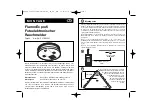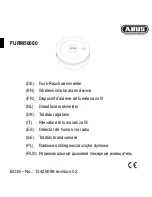
Page 10
WHAT TO DO IF CARBON MONOXIDE IS DETECTED:
If you hear the alarm horn sound 4 beeps, a 2 second pause (and then repeat),
carbon monoxide has been detected. Evacuate everyone from the building.
OPERATION, TESTING & MAINTENANCE
OPERATION:
The alarm is operating once the AC power is connected and turned on. When
products of combustion are sensed, the alarm sounds a loud alarm which continues until the air is
cleared.
This alarm incorporates the NFPA recognized horn signal for evacuation. During alarm mode, the
horn produces three beeps followed by a two second pause and then continually repeats.
READY/ACTIVE CONDITION:
The green LED is on and blinks off once approx. every 20 seconds
to indicate the alarm is properly functioning.
LOCAL ORIGINATING SMOKE ALARM CONDITION:
The green LED turns off and the red LED
blinks on approx. every second while the alarm emits a loud, pulsating alarm sound.
NON-ORIGINATING SMOKE ALARM CONDITION:
The red LED is off and the alarm emits a loud,
pulsating alarm.
GREEN LED:
The green LED blinks on approx. every 40 seconds whenever AC power is turned
on.
CO ALARM:
The alarm signal is 4 beeps, 2 second pause, repeat. The red LED blinks on in sync
with the cycle of 4 beeps.
GAS ALARM:
The alarm signal is 1 beep, 1 second pause, repeat. The blue LED blinks on in sync
with the horn beep every second.
NUISANCE ALARM:
If the horn signals and the red or blue LED’s blink on for no apparent reason
and no obvious hazard is present, please verify that the alarm is mounted in the correct location.
Reset the alarm as instructed in the Operational Summary.
SMOKE ALARM LATCHING LED INDICATOR:
The alarm had previously detected smoke and had
alarmed. The red LED is off and blinks on approx. every 5 seconds until reset. Follow the reset
instructions to remove the latching LED.
CO ALARM LATCHING LED INDICATOR:
The alarm had previously detected CO and had
alarmed. The red LED is off and blinks on approx. every 5 seconds until reset. Follow the reset
instructions to remove the latching LED.
GAS ALARM LATCHING LED INDICATOR:
The alarm had previously detected GAS and had
alarmed. The blue LED is off and blinks on approx. every 5 seconds until reset. Follow the reset
instructions to remove the latching LED.
TROUBLE / SERVICE ALARM:
Periodically, the alarm measurement circuit is tested. If an error
is detected, the alarm will sound 3 chirps approx. every 20 seconds. Reset the alarm. If the unit
does not reset, replace the alarm.
END-OF-SERVICE LIFE ALARM:
When it is time to replace your alarm, which is approximately
7 years of operation from initial power up, the alarm will sound 2 chirps approx. every 20 seconds.
Replace alarm immediately. The product end-of-service life notification can be temporarily silenced
for a 10 hour period for up to 20 days. After 20 days, the warning cannot be silenced. The alarm
should be replaced immediately.
RESET THE ALARM:
Press the TEST/SILENCE button for 10 seconds, or until the blue LED turns
on, and then release. This will clear the alarm latching LED's and clear the alarm origination. Reset
after each alarm event.
TESTING:
Test by pushing the Test button on the alarm cover until the alarm sounds, then release.
The alarm sounds if all electronic circuitry and horn are working. If no alarm sounds, the alarm
may have a power supply failure.
Test the alarm weekly to assure proper operation.
ALARM ORIGINATION:
QUICK FIND
®
Alarm Origination - In an interconnected system consisting
of any of these models: 5304, MI106, MDS107, MCN108, MICN109, MDSCN111, MP117, it may
be difficult to determine which alarm initiated the alarms to sound during an alarm event. This
QUICK FIND
®
feature will immediately allow you to locate the originating alarm once the alarms
have stopped sounding. To initiate QUICK FIND
®
, press the Test/Silence button on any alarm.
After releasing the button, the test sequence on this alarm will begin and last 5-20 seconds, and
then stop. The specific test sequence horn pattern is designated by the alarm type. Once this test
sequence ends, the originating alarm continues to sound for approx. 50 seconds, which provides
ample time to locate the originating alarm. Remember to reset tthe originating alarm in order to
clear the QUICK FIND
®
alarm origination and to return your system to normal operation. Refer to
the wiring instructions model interconnect compatibility section of this manual for additional
information. In a non-interconnected installation, it is necessary to test each alarm by pressing
and releasing the Test/Silence button to determine the originating alarm.
Actuation of your CO Alarm indicates the presence of carbon monoxide (CO), which can kill you.
In other words, when your CO Alarm sounds, you must not ignore it!




































